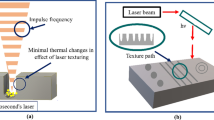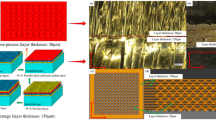Abstract
Cutter back-off and vibration are easily generated when machining of titanium alloy thin-walled parts due to its low rigidity, which has become the bottleneck for processing titanium alloy thin-walled parts. In order to investigate whether the impact force of air jet can reduce the part deformation and the vibration during machining process or not, experiments of milling Ti6Al4V alloy thin-walled part with and without air jet assistance were conducted. Vibration acceleration signals and cutting force signals in the milling process under the same cutting parameters are analyzed and compared. Also, vibration acceleration signals in frequency domain obtained by Fast Fourier Transform (FFT) are analyzed and compared. Furthermore, the impact force produced by air jet acting on the thin-walled part was collected separately before milling experiments and calculated according to the theory of hydromechanics to investigate its supporting effect. Finally, the experiment results show that air jet assistance can improve cutting stability and reduce cutting force, leading to better surface quality and reduced part deformation.
Similar content being viewed by others
References
Peters M, Kumpfert J, Ward CH, Leyens C (2003) Titanium alloys for aerospace applications. Adv Eng Mater 5(6):419–427. https://doi.org/10.1002/adem.200310095
Leyens C, Peters M (2003) Titanium and titanium alloys: fundamentals and applications. Wiley, Chichester. https://doi.org/10.1002/3527602119
Ezugwu EO, Wang ZM (1997) Titanium alloys and their machinability—a review. J Mater Process Technol 68(3):262–274. https://doi.org/10.1016/S0924-0136(96)00030-1
Rahman M, Wong YS, Zareena AR (2003) Machinability of titanium alloys. JSME Int J, Ser C 46(1):107–115. https://doi.org/10.1299/jsmec.46.107
Sun J, Guo YB (2009) Material flow stress and failure in multiscale machining titanium alloy Ti-6Al-4V. Int J Adv Manuf Technol 41(7–8):651–659. https://doi.org/10.1007/s00170-008-1521-6
Sun S, Brandt M, Dargusch MS (2009) Characteristics of cutting forces and chip formation in machining of titanium alloys. Int J Mach Tools Manuf 49(7–8):561–568. https://doi.org/10.1016/j.ijmachtools.2009.02.008
Chen G, Ren C, Yang X, Jin X, Guo T (2011) Finite element simulation of high-speed machining of titanium alloy (Ti–6Al–4V) based on ductile failure model. Int J Adv Manuf Technol 56(9–12):1027–1038. https://doi.org/10.1007/s00170-011-3233-6
Machai C, Iqbal A, Biermann D, Upmeier T, Schumann S (2013) On the effects of cutting speed and cooling methodologies in grooving operation of various tempers of β-titanium alloy. J Mater Process Technol 213(7):1027–1037. https://doi.org/10.1016/j.jmatprotec.2013.01.021
Sutter G, List G (2013) Very high speed cutting of Ti–6Al–4V titanium alloy – change in morphology and mechanism of chip formation. Int J Mach Tools Manuf 66:37–43. https://doi.org/10.1016/j.ijmachtools.2012.11.004
Gang L (2009) Study on deformation of titanium thin-walled part in milling process. J Mater Process Technol 209(6):2788–2793. https://doi.org/10.1016/j.jmatprotec.2008.06.029
Huang P, Li J, Sun J, Ge M (2012) Milling force vibration analysis in high-speed-milling titanium alloy using variable pitch angle mill. Int J Adv Manuf Technol 58(1–4):153–160. https://doi.org/10.1007/s00170-011-3380-9
Sima M, Özel T (2010) Modified material constitutive models for serrated chip formation simulations and experimental validation in machining of titanium alloy Ti–6Al–4V. Int J Mach Tools Manuf 50(11):943–960. https://doi.org/10.1016/j.ijmachtools.2010.08.004
Gandhi MV, Thompson BS (1984) Phase-change fixturing for FMS. Manuf Eng 93(6):79–80
Gandhi MV, Thompson BS (1985) Phase change fixturing for flexible manufacturing systems. J Manuf Syst 4(1):29–39. https://doi.org/10.1016/0278-6125(85)90005-6
Obara H, Watanabe T, Ohsumi T, Ninomiya E, Hatano M (2002) A method to machine three-dimensional thin parts. Initiatives Precis Eng Beginning Millennium-Springer US 87-91. doi:https://doi.org/10.1007/0-306-47000-4_16
Korobko EV, Gorodkin RG, Ragotner MM (1993) ERF used for fixing blanks when machining their surface. Belarus Acad Sci Belarus 1:993
Zhou K, Zhao JS, Mao DZ (2002) Research on an intelligent manufacturing system based on an information-localizing machining mode. J Mater Process Technol 129(1–3):597–602. https://doi.org/10.1016/S0924-0136(02)00658-1
Ma C, Shamoto E, Moriwaki T, Wang L (2004) Study of machining accuracy in ultrasonic elliptical vibration cutting. Int J Mach Tools Manuf 44(12–13):1305–1310. https://doi.org/10.1016/j.ijmachtools.2004.04.014
Li X, Zhang D (2006) Ultrasonic elliptical vibration transducer driven by single actuator and its application in precision cutting. J Mater Process Technol 180(1–3):91–95. https://doi.org/10.1016/j.jmatprotec.2006.05.007
Li W, Zhang DY (2011) High frequency ultrasonic elliptical vibration turning study for weak rigidity precision workpiece. Key Eng Mater 467-469:236–240 https://doi.org/10.4028/www.scientific.net/KEM.467-469.236
Zhang L, Zheng L (2005) Prediction of cutting forces in end milling of pockets. Int J Adv Manuf Technol 25(3–4):281–287. https://doi.org/10.1007/s00170-003-1841-5
Antonialli AIS, Diniz AE, Pederiva R (2010) Vibration analysis of cutting force in titanium alloy milling. Int J Mach Tools Manuf 50(1):65–74. https://doi.org/10.1016/j.ijmachtools.2009.09.006
Chattopadhyay H, Saha SK (2003) Turbulent flow and heat transfer from a slot jet impinging on a moving plate. Int J Heat Fluid Flow 24(5):685–697. https://doi.org/10.1016/S0142-727X(03)00062-6
Ersson M, Tilliander A, Jonsson L, Jönsson P (2008) A mathematical model of an impinging air jet on a water surface. ISIJ Int 48(4):377–384. https://doi.org/10.2355/isijinternational.48.377
Fan JM, Wang CY, Wang J (2009) Modeling the erosion rate in micro abrasive air jet machining of glasses. Wear 266(9–10):968–974. https://doi.org/10.1016/j.wear.2008.12.019
Nie BS, Wang H, Li L, Zhang J, Yang H, Liu Z, Wang LK, Li HL (2011) Numerical investigation of the flow field inside and outside high-pressure abrasive waterjet nozzle. Procedia Eng 26(4):48–55. https://doi.org/10.1016/j.proeng.2011.11.2138
Semercigil SE, Chen LA (2002) Preliminary computations for chatter control in end milling. J Sound Vib 249(3):622–633. https://doi.org/10.1006/jsvi.2001.3740
Wang M, Li JN, Yuan WJ, Xie CL, Fei RY (2003) Computer simulation and experimental study on the stability of milling processes. J Beijing Polytechnic Univ 29(3):292–295
Huang PL, Li JF, Sun J, Jia XM (2016) Cutting signals analysis in milling titanium alloy thin-part components and non-thin-wall components. Int J Adv Manuf Technol 84(9–12):2461–2469. https://doi.org/10.1007/s00170-015-7837-0
Funding
The work was supported by the National Natural Science Foundation of China (No.51275277).
Author information
Authors and Affiliations
Corresponding author
Rights and permissions
About this article
Cite this article
Liu, C., Sun, J., Li, Y. et al. Investigation on the milling performance of titanium alloy thin-walled part with air jet assistance. Int J Adv Manuf Technol 95, 2865–2874 (2018). https://doi.org/10.1007/s00170-017-1420-9
Received:
Accepted:
Published:
Issue Date:
DOI: https://doi.org/10.1007/s00170-017-1420-9




